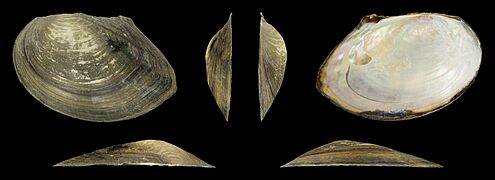Chinese pond mussel facts for kids
Quick facts for kids Chinese pond mussel |
|
|---|---|
 |
|
| Two live Chinese pond mussels in Japan | |
 |
|
| In the March River, Austria | |
| Conservation status | |
| Scientific classification | |
| Genus: |
Sinanodonta
|
| Species: |
woodiana
|
| Synonyms | |
|
Anodonta woodiana (I. Lea, 1834) |
|
The Chinese pond mussel, also known as Sinanodonta woodiana, is a type of freshwater mussel. It's an aquatic creature, meaning it lives in water. It's a bivalve, which means it has two shells that hinge together, like a clam. This mussel belongs to the Unionidae family, often called river mussels.
Contents
Where Do Chinese Pond Mussels Live?
The Chinese pond mussel originally comes from Eastern Asia. However, it has spread to many other parts of the world. This makes it an "introduced" or "non-native" species in those places.
In Europe
You can find these mussels in many European countries, including:
- Austria
- Belgium
- Croatia
- Czech Republic
- France
- Germany
- Greece
- Hungary
- Italy
- Poland
- Romania
- Serbia
- Slovakia
- Spain
- Ukraine
- Switzerland
In Other Parts of the World
They have also been found in:
- Some islands in Indonesia
- The Americas, including Costa Rica, the Dominican Republic, and the United States (though they are no longer found in New Jersey).
- Africa, specifically in Algeria since 2023.
- Asia, for example, in Myanmar since 2017.
Life and Habits of the Chinese Pond Mussel
The Chinese pond mussel is a large freshwater bivalve. It is mostly found in rivers like the Amur River in Russia and the Yangtze River in China. These mussels can grow quite big, up to 30 centimeters (about 12 inches) long. They can also live for a long time, usually 12 to 14 years.
Growing Up and Spreading
These mussels can start having babies by the end of their first year. At this point, they are only about 3 to 4 centimeters long. They are very adaptable and can live in many different types of watery places. They can even handle water that has a lot of silt (muddy sediment).
Like all river mussels, the Chinese pond mussel has a special way of growing. Their young, called glochidium, must attach themselves to a host fish. They stay on the fish for a short time to finish developing. Many different types of fish can be hosts for these young mussels.
Why Are They So Successful?
The Chinese pond mussel has spread widely around the world. One big reason for this is the movement of Asian carp. These fish are the natural hosts for the mussel's young. When Asian carp were moved to new places for farming or other reasons, the mussels often came along for the ride.
Sometimes, these mussels were even brought to new places on purpose. For example, in Italy, they were introduced to try and make artificial pearls. They are also sold in some garden centers to help clean outdoor ponds. This is called biofiltration.
What About Other Animals?
When Chinese pond mussels move into a new area, they can sometimes affect the local mussel populations. They might compete for food or space.
Mussel Parasites
Like many animals, these mussels can have parasites. One known parasite is called Aspidogaster conchicola.




